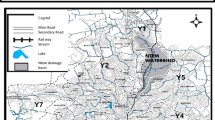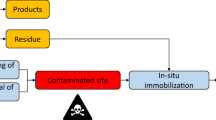Abstract
Municipal landfill soils are not able to retain heavy metals indefinitely, and these metals can migrate into the groundwater. Environmental contamination induced by toxic metals creates a societal health risk. The objective of this work is to study the ability of landfill soil to retain metals (Pb, Cd, Cu, Fe and Zn). The soil came from the municipal solid waste dump of the City of Yamoussoukro (Côte d’Ivoire). Operating parameters such as thickness of soil, metal concentration and filtered volume were investigated. A factorial experimental design was used to determine which parameters influence the metal retention rate. Thickness of soil and metal concentration were the most important factors influencing metal retention. Using a 23 factorial matrix, the best performances for metal retention (99.8–100 % removal) were obtained by selecting a thickness of soil of 2.0 cm, an initial metal concentration of 50 mg L−1 and 200 mL of metallic solution. The optimal experimental conditions for metal retention were then investigated using the Excel Solver program. Between 98.9 and 99.9 % of the metals were retained in subsequent experiments using these optimal conditions (soil thickness ranging between 10 and 14 cm and metal concentration of up to 300 mg L−1 in 400 mL of metallic solution).






Similar content being viewed by others
References
Adriano, D., Wenzel, W., Vangronsveld, J., & Bolan, N. S. (2004). Role of assisted natural remediation in environmental cleanup. Geoderma, 122, 121–142.
Aloueimine, S. O. (2006). Methodology for characterization of waste in Nouakchott (Mauritania): contribution to the waste management tools and decision support. PhD Dissertation, University of Limoges.
Assidjo, E., Yao, B., Akou, E., & Ado, G. (2005). Optimisation of the treatment conditions of cocoa butter in order to reduce non‐quality. Journal of chemometrics, 19, 543–548.
Bozkurt, S., Moreno, L., & Neretnieks, I. (2000). Long-term processes in waste deposits. Science of the total environment, 250, 101–121.
Chaperon, S., & Sauvé, S. (2008). Toxicity interactions of cadmium, copper, and lead on soil urease and dehydrogenase activity in relation to chemical speciation. Ecotoxicology and Environmental Safety, 70, 1–9.
Chatain, V. (2004). Characterization of the potential mobilization of arsenic and other inorganic constituents in soils from a gold mining site. PhD Dissertation, National Institute of Applied Science of Lyon.
De Matos, A., Fontes, M., Da Costa, L., & Martinez, M. (2001). Mobility of heavy metals as related to soil chemical and mineralogical characteristics of Brazilian soils. Environmental Pollution, 111, 429–435.
Drogui, P., Mercier, G., & Blais, J.-F. (2005). Bioproduction of ferric sulfate used during heavy metals removal from sewage sludge. Journal of environmental quality, 34, 816–824.
Feinberg, M. (1996). La validation des méthodes d’analyse. Une approche chimiométrique de l’assurance qualité au laboratoire. Ed. Masson, 457 p.
Goupy, J. (2006). Les plans d’expériences. Revue MODULAD. Tutoriel, 34, 74–116.
Guo, G., Yuan, T., Wang, W., Li, D., Cheng, J., Gao, Y., & Zhou, P. (2011). Bioavailability, mobility, and toxicity of Cu in soils around the Dexing Cu mine in China. Environmental geochemistry and health, 33, 217–224.
Kouamé, I. K., Gomé, D. L., Savané, I., Kouassi, E. A., Koffi, K., Goula, B. T. A., & Diallo, M. (2006). Mobilité relative des métaux lourds issus de la décharge d’Akouédo et risque de contamination de la nappe du Continental Terminal (Abidjan-Côte d’Ivoire). Afrique Science, 02(1), 39–56.
Kouassi, A. E., Ahouassi, K. E., Koffi, Y. B., Kouamé, I. K., Soro, N., & Biémi, J. (2014). Caractérisation physicochimique du luixiviat d’une décharge de l’Afrique de l’Ouest: cas de la décharge d’Akouédo (Abidjan-Côte d’Ivoire). Larhyss Journal, 19, 63–74.
Lu, Y., Yin, W., Huang, L., Zhang, G., & Zhao, Y. (2011). Assessment of bioaccessibility and exposure risk of arsenic and lead in urban soils of Guangzhou City, China. Environmental geochemistry and health, 33, 93–102.
Mercier, G., Duchesne, J., & Carles-Gibergues, A. (2002). A new in vitro test to simulate gastric absorption of copper, lead, tin and zinc from polluted soils Mise au Point d’un Test In Vitro Simulant le Suc Gastrique pour Dépister les Sols Contaminés par le Cuivre, le Plomb, l’Étain et le Zinc. Environmental technology, 23, 121–133.
Pereira, B. & Sonnet, P. (2007). La contamination diffuse des sols par les éléments traces métalliques en région wallonne. Etudes-Expertises. Etat de l’environnement wollon. UCL, 27 p.
Robinson, G. W. (1949). Soils. Their origin, constitution and classification. London: Thomas Murby and Co, N.Y.J. Wiley and Sons Inc., 573 p.
Rouiller, J., Souchier, B., Bruckert, S., Feller, C., Toutain, F., & Verdy, J. C. (1994). Méthodes d’analyses des sols. In M. Bonneau & B. Souchier (Eds.), Pédologie: constituants et propriétés du sol. Tome II (pp. 619–952). Paris: Masson.
USEPA. (1997). Clean up the nation’s waste sites: markets and technology trends. Washington, DC: EPA/542/R/96/005, U.S. Environmental Protection Agency.
Venkateswaran, P., Vellaichamy, S., & Palanivelu, K. (2007). Speciation of heavy metals in electroplating industry sludge and wastewater residue using inductively coupled plasma. International Journal of Environmental Science & Technology, 4, 497–504.
Yao, B., Assidjo, E., Gueu, S., & Ado, G. (2005). Study of hibiscus esculentus mucilage coagulation-floculation activity. Journal of Applied Sciences and Environmental Management, 9(1), 173–176.
Yatribi, A., & Nejmeddine, A. (2000). Heavy metals fractionnation and mobility in soil downstream of tannery wastewaters. France: Revue des Sciences de l’Eau.
Yobouet, Y., Adouby, K., Trokourey, A., & Yao, B. (2010). Cadmium, copper, lead and zinc speciation in contaminated soils. International Journal of Engineering Science and Technology, 2, 802–812.
Yobouet, Y. A., Adouby, K., Trokourey, A., & Yao, B. (2013). Soils pollution in some metals in a solid waste dump in Yamoussoukro, Cote d’Ivoire. International Journal of Current Research, 5(1), 112–118.
Acknowledgments
Sincere thanks are extended to the Association of Universities and Colleges of Canada and International Development Research Centre for their financial support.
Author information
Authors and Affiliations
Corresponding author
Electronic supplementary material
Below is the link to the electronic supplementary material.
Table SM1
(DOCX 17 kb)
Rights and permissions
About this article
Cite this article
Yobouet, Y.A., Adouby, K. & Drogui, P. Experimental Methodology to Assess Retention of Heavy Metals Using Soils from Municipal Waste Landfills. Water Air Soil Pollut 227, 37 (2016). https://doi.org/10.1007/s11270-015-2706-x
Received:
Accepted:
Published:
DOI: https://doi.org/10.1007/s11270-015-2706-x




